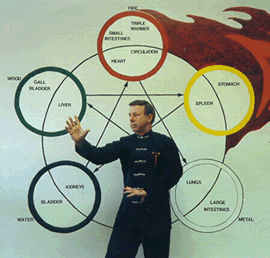The five elements of Hsing-I were developed by observing and imitating the essential qualities of natural forces.
Water always seeks its own level flowing downward and accumulating or sinking in. Fire, being less dense than water, rises. Wood can be made into a variety of shapes, either curved or straight. Metal can be forged, melted, refined, and made pliable or unyielding. Earth is the source of nourishment and can generate all other elements.
In Hsing-I theory, the basis of the complementary relationships among the five elements is defined by the principles of mutual creation and mutual destruction. According to the principle of mutual creation, metal creates water, water creates wood, wood creates fire, fire creates earth and earth creates metal. In nature, the geological and chemical forces at work within the earth serve to create metal. Metal itself becomes liquid as it melts when encountering sufficient heat. Water, combined with the nutrients of the earth, creates wood. With the proper application of friction and heat, wood, in turn, creates fire. When wood is reduced to ashes, it becomes a component of soil thus creating earth. The principle of mutual destruction holds that metal, in the form of tools, such as saws and axes, can destroy wood. The elements of water overcomes fire. Wood can overcome earth by depleting the minerals and nutrients which make it fertile. Fire consumes wood and earth traps water in depressions and dams.

